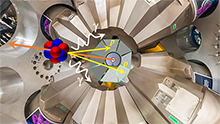UK-funded FAUST project to enable new experiments at FRIB

Share this article:
Share this article:
University of Surrey article details how sensors will shine new light on why stars explode
The University of Surrey in England published an article (“£3m Surrey sensors will shine new light on why stars explode”) that discusses how the United Kingdom Research and Innovation (UKRI) Science and Technology Facilities Council (STFC) is funding the FRIB Accelerated-beams for Understanding Science and Technology (FAUST) instrument, which will enable new experiments at FRIB. This investment benefits FRIB and its user community.
The UK team visited FRIB 16-18 January and planning is underway.
The full article is reprinted below.
£3m Surrey sensors will shine new light on why stars explode
Detectors that can stop very high-energy particles in their tracks and measure the speed at which reactions take place inside stars are being developed at the University of Surrey.
The £3.4m FAUST project, funded by UK Research and Innovation’s Science and Technology Facilities Council (UKRI-STFC), will develop detectors to sit inside the new GRETA gamma-ray array. This forms part of the $730m Facility for Rare Isotope Beams (FRIB) particle accelerator at Michigan State University (MSU), USA.
FAUST stands for “FRIB-Accelerated Beams for Understanding Science and Technology."
MSU operates FRIB as a user facility for the U.S. Department of Energy Office of Science (DOE-SC), supporting the mission of the DOE-SC Office of Nuclear Physics and a global user community of 1,800 scientists.
Professor Gavin Lotay, Director of Research and Innovation, said:
“Slowing down particles that are moving close to the speed of light is certainly a challenge. But with our partners, we’re confident in building equipment fit for the task. The findings could one day help us unlock the mysteries of how reactions at the heart of stars create the elements that make up everything on earth and across galaxies.
It’s amazing to think that reactions involving tiny nuclei, invisible to the naked eye, determine how a star explodes.”
Almost all chemical elements like gold, oxygen, and iron are produced by nuclear reactions in stars. To learn more about where they come from, scientists need a deeper understanding of how these reactions take place.
Scientists will smash beams of speedy rare isotopes into various forms of plastic targets. By measuring the emerging light-charged particles (such as protons) that are produced, they hope to learn about the origins of elements from gold to oxygen and beyond.
The particles will be measured by a combination of silicon detectors, supplied by West Sussex-based Micron Semiconductor Ltd., and caesium iodide crystals, developed by colleagues at the University of York.
The UKRI-STFC Daresbury Laboratory in Cheshire will provide important technical support.
Dr. Alexandra Gade, FRIB Scientific Director and Professor of Physics at MSU, said:
“We’re excited to welcome FAUST and the associated research to FRIB.
This international collaboration will answer fundamental questions about the evolution of the universe and the nature of the nuclear force – and we very much look forward to this partnership.”
The device is due to be completed in 2028. It is expected to operate for at least 10 years.
This research contributes to the UN Sustainable Development Goal 9 (industry, innovation and infrastructure).
Read the original article on the University of Surrey website.
Michigan State University operates the Facility for Rare Isotope Beams (FRIB) as a user facility for the U.S. Department of Energy Office of Science (DOE-SC), supporting the mission of the DOE-SC Office of Nuclear Physics. Hosting what is designed to be the most powerful heavy-ion accelerator, FRIB enables scientists to make discoveries about the properties of rare isotopes in order to better understand the physics of nuclei, nuclear astrophysics, fundamental interactions, and applications for society, including in medicine, homeland security, and industry.
The U.S. Department of Energy Office of Science is the single largest supporter of basic research in the physical sciences in the United States and is working to address some of today’s most pressing challenges. For more information, visit energy.gov/science.

